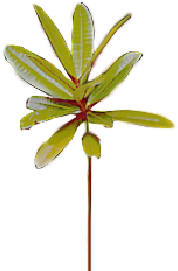

|
Tumucumaque |
ARPA The Amazon Region Protected Areas (ARPA) program is a sweeping safeguard for the Amazon rain forest. It will ensure the survival of Earth's richest biological treasures. This is a partnership with the Brazilian Government, the Brazilian Biodiversity Fund (FUNBIO), the German Development Bank (KFW), the Global Environmental Facility, Greenspan, WWF, Conservation International, and many others. It's a ten year effort to save an additional 33% of the Amazon rain forest. July, 3, 2004 - By Melissa Mathis, Greenspan |
The Brazilian
Amazon basin contains the largest tropical rain forest reserve.
|
|
|
|
PLAN TO SAVE THE AMAZON President Cardoso of Brazil signed an agreement to preserve 1/3rd of the Amazon. TUMUCUMAQUE (too-moo-koo-mah-kay) was the first ARPA reserve. It's four times the size of Yellowstone. Creating National Parks A full third of the Amazon rainforest was set to be preserved. ARPA RESERVES View a list of reserves.
Brazil creates largest rainforest reserve. New Green Corridor Creates Brazilian 'Super-Park' This "conservation corridor" links 25 million acres of pristine wilderness. Apui Mosaic A a mosaic of protected areas totaling over three million hectares in the Brazilian state of Amazonas was created.
Brazil Creates Two Rainforest Reserves. NEW AMAZON RESERVE The creation of Chandless State Park is larger than the state of Delaware. Forest Clings on in Brazil A few hotspots hold the key to saving endangered species. THE AMAZON is home to over half of the world's species. It's the lungs of the planet, and the pharmacy of the world. |
Recently,
the most important step towards staggering the rate of destruction to
the rain forests has been taken, with optimum results. The most
ambitious rain forest initiative ever, the Amazon Region Protected Areas
(ARPA) program, will preserve an additional full third of the Amazon. Over 81 million dollars has been generated towards this program to protect the land indefinitely; the projected amount necessary to secure the area's future is $395 million. The funding allows for forest rangers and surveillance equipment to combat illegal logging and poaching, and also takes into account an emergency management plan. Because of this program, the world's largest reserve is now the Tumucumaque Mountains National Park - consisting of 9,500,000 acres of pristine rain forest land. President Cardoso of Brazil said of the park, "Plants and animals that are endangered elsewhere will continue to thrive in our forests forever." About 30% of the world's animal, plant, and insect life inhabit Tumucumaque.  This is a viable step towards not only conservation but also impending breakthroughs in medical research that have previously been stonewalled. In Malaysia, a single species of tree (Calophyllum Lanigerum) is being studied for extracts which scientists have high hopes for implementing cures for HIV and AIDS as well as tuberculosis. It will save millions of lives all around the world.
Half of all modern medicines are derived solely from rain forest
plants. Prominent examples are: novocaine, turbocuarine (a muscle
relaxant used for surgery, Parkinson's disease, and multiple sclerosis),
cortisone (an active ingredient in birth control pills), and quinine for
anti-malarial and pneumonia. The amount of medicines and their benefits
are staggering. |
Web Design by
Lucid Dream
Studios